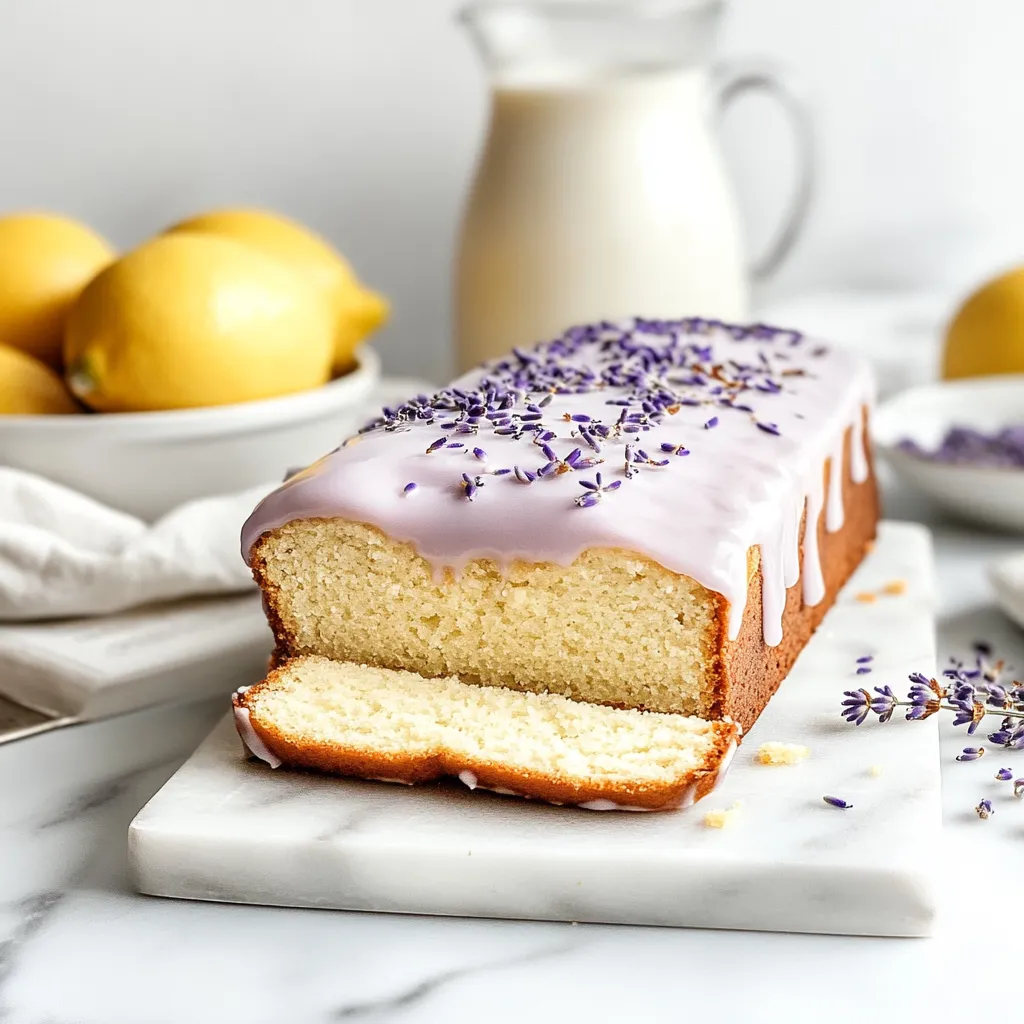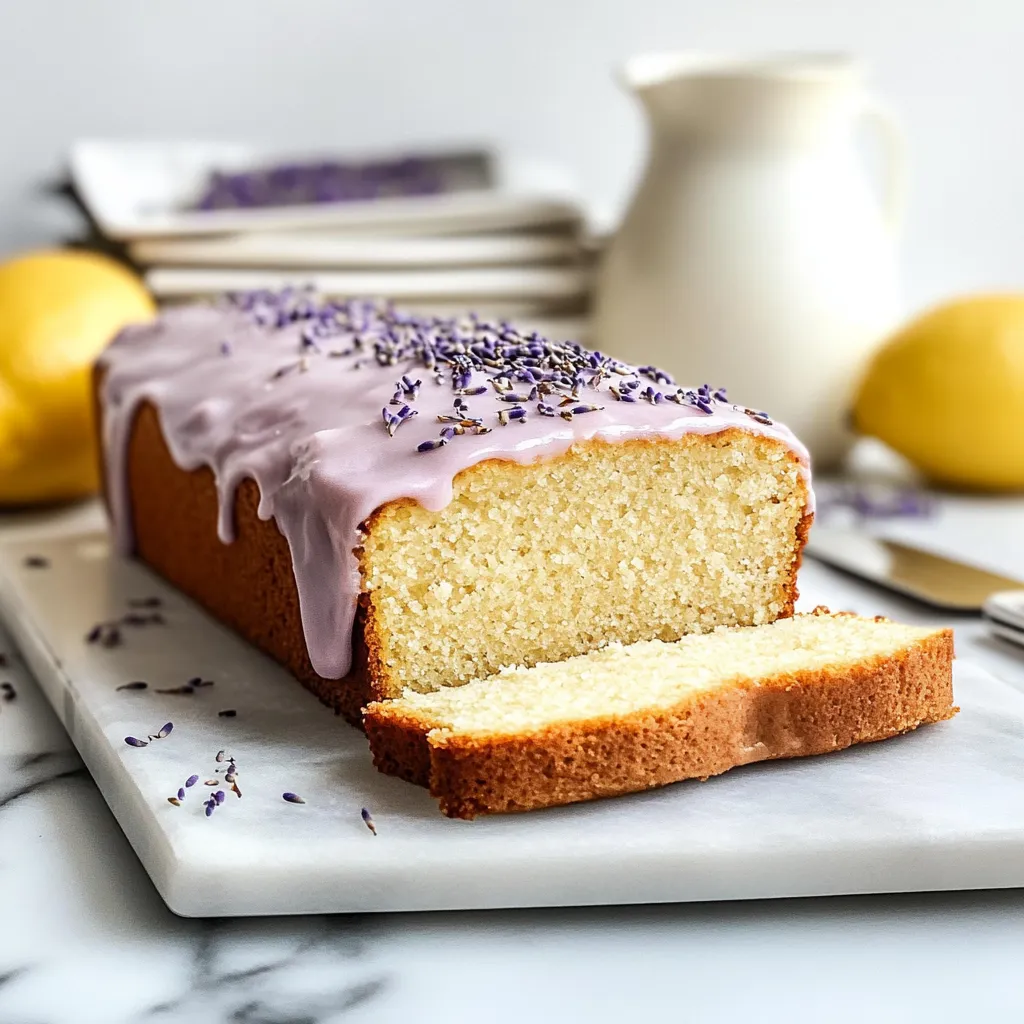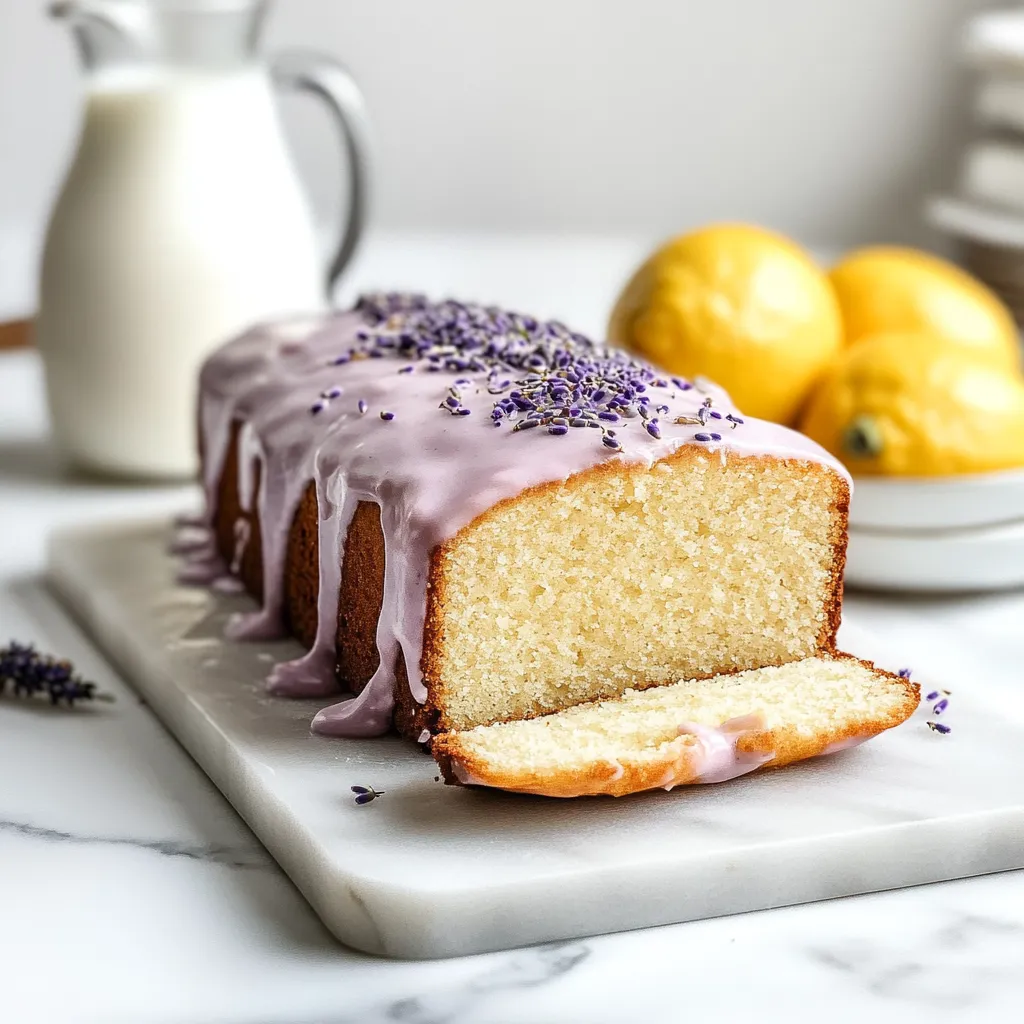 Pin it
Pin it
Lemon Lavender Loaf Cake captures the essence of springtime in every slice, balancing bright citrus notes with delicate floral undertones that dance across your palate. This elegant loaf achieves its remarkable flavor through methodical technique—lemon zest rubbed with sugar to release essential oils, freshly squeezed juice for vibrant acidity, and culinary lavender bloomed in warm oil to unlock its subtle complexity. The result is a tender, moist cake with a perfect crumb that delivers sophisticated flavor without overwhelming the senses. Each forkful offers the invigorating brightness of lemon followed by a gentle whisper of lavender that lingers pleasantly, creating a sensory experience that elevates this humble loaf beyond ordinary citrus cakes into something truly memorable.
I developed this recipe while seeking to capture the essence of my grandmother's garden, where lemon trees and lavender bushes grew side by side. The first time I served it at a spring brunch, conversations stopped mid-sentence as guests tried to identify the mysterious floral note behind the bright lemon flavor. Three different people asked for the recipe before dessert was finished, and my brother-in-law—who typically avoids "fancy" desserts—requested it specifically for his birthday celebration. This cake has since become my signature contribution to spring and summer gatherings, reliably eliciting that perfect moment of surprise and delight with every first bite.
Perfect Ingredients
- Culinary lavender (2 tablespoons): Provides delicate floral notes without soapy overtones
- Canola oil (½ cup): Creates a moisture-rich base while blooming lavender flavors
- Lemons (3 medium): Deliver bright citrus through both zest and juice
- Granulated sugar (1 cup): Sweetens while helping release essential oils from lemon zest
- Large eggs (3): Create structure and richness for perfect texture
- Vanilla extract (1 teaspoon): Rounds out the flavor profile with warm undertones
- All-purpose flour (1¾ cups): Provides the structural foundation for a tender crumb
- Baking powder (2 teaspoons): Creates the perfect rise for a light, fluffy texture
- Salt (½ teaspoon): Enhances all flavors while balancing sweetness
- Greek yogurt (⅓ cup): Adds moisture and a subtle tang that complements the lemon
Loaf Creation
Lavender Blooming
Begin with the most crucial flavor-building step—blooming the lavender. Heat canola oil in a medium saucepan over medium-high heat for just one minute, until it's warm but not smoking. Immediately remove from heat and stir in the culinary lavender. Cover the pot with a tight-fitting lid, trapping the heat inside to gently coax the essential oils from the dried buds without burning them. Allow this mixture to steep for at least 30 minutes, though a full hour develops even more complex flavor. The oil will transform, taking on a subtle purple hue and the distinctive fragrance of lavender. Strain through a fine-mesh sieve, pressing gently on the buds to extract every drop of flavored oil.
Lemon Intensification
While the lavender blooms, prepare the lemons using a technique that maximizes their flavor potential. Zest the lemons carefully, avoiding the bitter white pith, then place this fragrant zest in a bowl with the granulated sugar. Using your fingertips, rub the zest vigorously into the sugar—this abrasive action ruptures the essential oil sacs in the zest, releasing their aromatic compounds. Continue until the sugar takes on a light yellow tint and the lemon fragrance intensifies dramatically. This simple step transforms ordinary lemon flavor into something extraordinarily vibrant. Set aside the rubbed zest-sugar mixture while juicing the naked lemons to extract their tart liquid.
Aeration Foundation
In the bowl of a stand mixer fitted with the whisk attachment, combine the eggs with the lemon-infused sugar and vanilla extract. Beat on high speed for a full 3-4 minutes—this extended mixing is not excessive but essential. The mixture will transform dramatically, tripling in volume and becoming pale yellow and luxuriously fluffy. This aeration creates the foundation for the cake's light texture. The mixture should form ribbons when the whisk is lifted, indicating that sufficient air has been incorporated to create the perfect crumb structure in the finished cake.
Oil Incorporation
With the mixer running at medium speed, slowly drizzle in the lavender-infused oil in a thin, steady stream. This gradual addition prevents the oil from deflating the carefully incorporated air. The oil should be fully integrated into the batter, creating an emulsion that will keep the cake moist even days after baking. After all the oil has been added, continue beating for another 30 seconds to ensure complete incorporation. The batter will appear glossy and smooth, with a unified consistency that indicates proper emulsification.
Alternating Additions
In a separate bowl, whisk together the flour, baking powder, and salt until evenly distributed. Begin the incorporation process by adding one-third of this dry mixture to the batter, mixing on low speed just until combined. Follow with half the yogurt and lemon juice, again mixing minimally. Continue this alternating pattern—dry, wet, dry, wet, finishing with the final third of dry ingredients. This methodical approach prevents gluten development while ensuring even distribution of leavening agents and moisture. The finished batter should be smooth and pourable, with a consistency similar to thick pancake batter.
Gentle Baking
Pour the batter into a 9x5-inch loaf pan that has been thoroughly greased and lined with parchment paper for easy removal. The parchment should extend over the long sides to create handles for lifting the finished cake. Bake in a preheated 350°F oven for 45-50 minutes, until a toothpick inserted in the center comes out with a few moist crumbs but no wet batter. The top should be golden brown and spring back when lightly touched. This gentle baking temperature allows the cake to rise evenly without developing a pronounced dome or cracking, resulting in a perfectly shaped loaf.
Cooling Patience
Allow the cake to cool in the pan for exactly 10 minutes—this timing is crucial. If removed too soon, the structure will not have set enough to support itself; if left too long, the bottom may become soggy from trapped steam. After this initial cooling period, use the parchment handles to gently lift the cake from the pan and transfer to a wire rack to cool completely. This could take up to two hours, but patience is rewarded with perfect texture. The cake must be completely cool before glazing to prevent the glaze from melting and being absorbed into the cake rather than creating a distinct layer on top.
 Pin it
Pin it
My grandmother always said that baking with flowers required a gentle hand and patient heart. "Too much lavender and you're eating soap; too little and why bother?" she would tell me as we harvested sprigs from her garden. This cake honors her wisdom about botanical balance—the lavender doesn't announce itself boldly but rather complements the lemon like a whispered secret. Whenever I serve this cake, I'm reminded of afternoons in her sunlit kitchen, where she taught me that the most memorable flavors often come from unexpected combinations handled with care and respect for each ingredient's unique character.
Serving Suggestions
Serve thin slices of this elegant loaf on small plates with a dollop of lightly sweetened whipped cream or crème fraîche. For afternoon tea, pair with Earl Grey or a delicate white tea that won't overpower the cake's subtle lavender notes. During summer, serve alongside fresh berries for a colorful and complementary flavor pairing. For a more substantial dessert, warm slices slightly and top with a scoop of vanilla bean ice cream, which melts slightly into the cake for an additional layer of creamy richness against the bright citrus and floral notes.
Creative Variations
Transform this versatile loaf by incorporating different flavor combinations while maintaining the basic technique. Replace lavender with fresh thyme or rosemary for a more herbaceous profile that still pairs beautifully with lemon. Create a winter version by substituting orange zest and juice for the lemon, pairing it with warm spices like cardamom instead of lavender. For special occasions, add a handful of fresh blueberries to the batter just before baking for bursts of juicy fruit that complement both the lemon and lavender. A lemon-vanilla version can be created by omitting the lavender and doubling the vanilla for a more familiar but equally delicious loaf.
Storage Solutions
This cake maintains its moisture remarkably well, stored properly at room temperature in an airtight container for up to four days. In fact, many find the lavender flavor develops more fully on the second day. For longer storage, wrap individual slices tightly in plastic wrap and freeze for up to three months. Thaw wrapped slices at room temperature for about an hour before serving. If you've glazed the cake, it's best consumed within two days, as the glaze may begin to soften and be absorbed into the cake with extended storage, though this affects appearance more than flavor.
I've created many loaf cakes throughout my baking journey, but this lemon lavender version remains one of my proudest achievements for its perfect balance of familiar and unexpected flavors. There's something magical about watching people take their first bite—the initial recognition of lemon followed by that moment of surprise as the lavender reveals itself. While the techniques may seem fussy, each step serves a purpose in developing the complex flavor profile that makes this cake so memorable. It reminds me that sometimes the most impressive results come not from complex ingredients or intricate decorations, but from thoughtful treatment of simple components, allowing each to shine in harmony with the others.
 Pin it
Pin it
Frequently Asked Questions
- → What is culinary lavender and where can I find it?
- Culinary lavender is specifically grown for cooking and baking with a milder flavor than ornamental varieties. Find it at specialty food stores, farmers markets, or online. Make sure it's labeled 'culinary' or 'food grade'.
- → Can I substitute dried lavender for fresh?
- Yes, but use about 1/3 less dried lavender than fresh as it's more concentrated. So if a recipe calls for 1 tablespoon fresh, use 1 teaspoon dried instead.
- → How can I prevent my loaf cake from being too dense?
- Don't overmix the batter once you add the flour, measure flour correctly by spooning into cups rather than scooping, and make sure ingredients are at room temperature before starting.
- → Can I make this cake without a stand mixer?
- Absolutely! Use a hand mixer or even whisk by hand - just make sure to beat the eggs and sugar thoroughly until they're very light and fluffy before adding other ingredients.
- → How do I know when the cake is done baking?
- Insert a toothpick into the center - it should come out clean or with a few moist crumbs. Also, the cake should spring back when lightly pressed and start to pull away from the sides of the pan.
